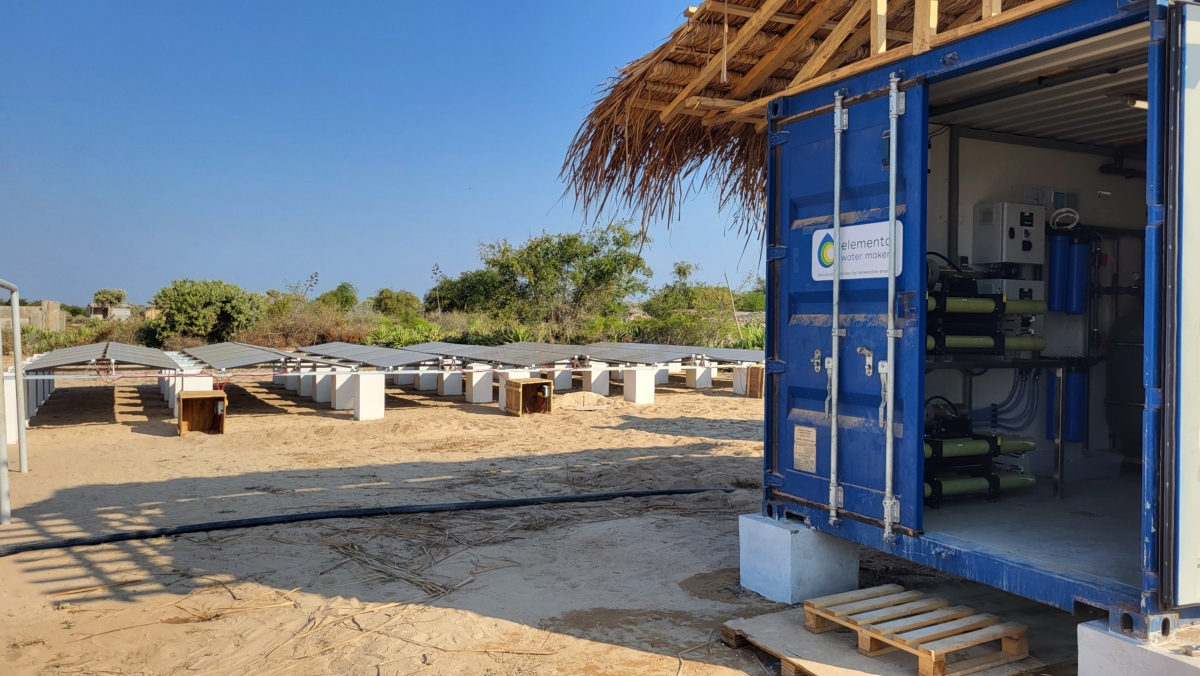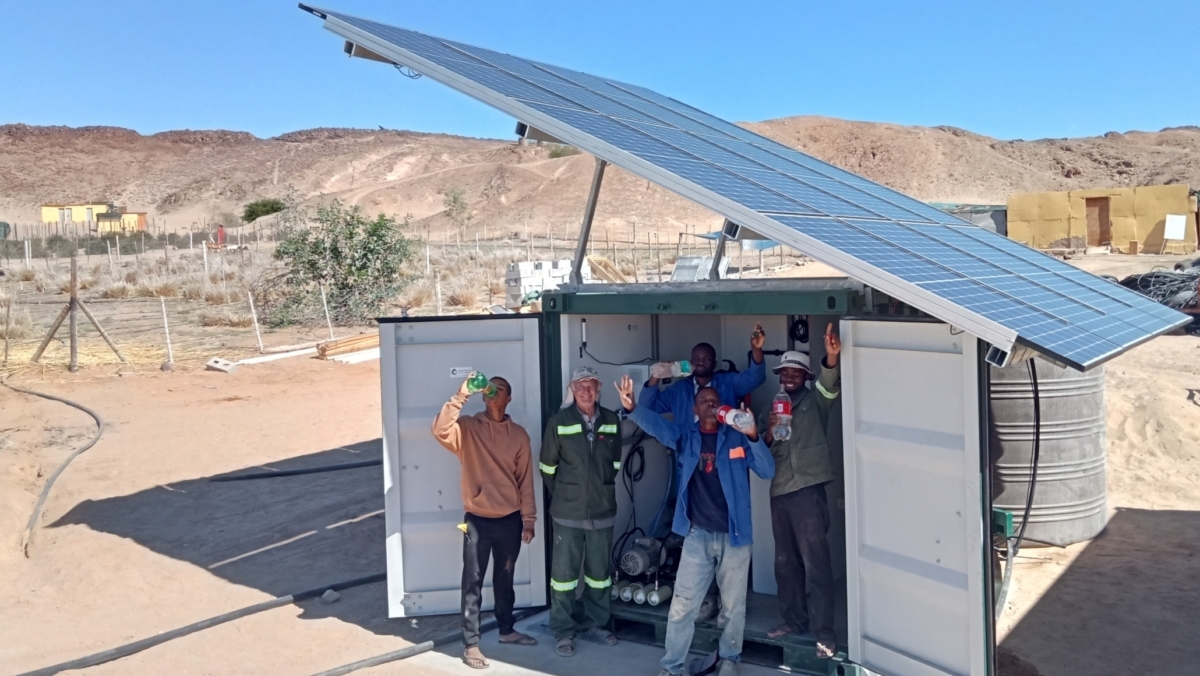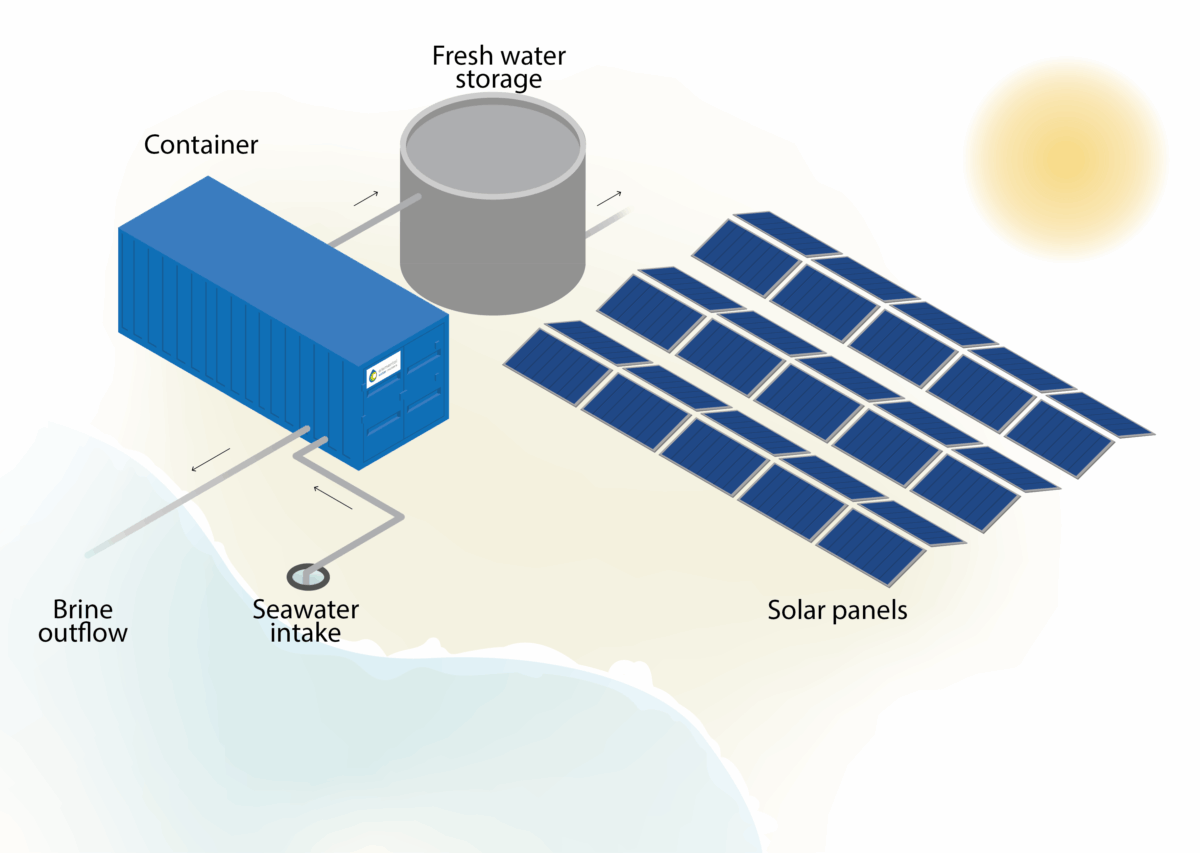Solar desalination combines the power of the sun with advanced filtration technology to transform seawater into fresh drinking water. This sustainable process uses solar panels to generate electricity that powers reverse osmosis membranes, which remove salt and minerals from seawater under pressure. The result is clean, fresh water that meets WHO drinking water standards, all without relying on traditional electricity grids or producing carbon emissions during operation.
What exactly is solar desalination? #
Solar desalination is a water treatment process that harnesses renewable solar energy to remove salt and minerals from seawater, producing fresh drinking water without depending on conventional power sources. At its core, this technology combines photovoltaic solar panels with desalination equipment to create a self-sufficient water production system.
The basic principle involves using sunlight to generate electricity through solar panels, which then powers the desalination process. This approach is particularly valuable for coastal regions where traditional freshwater sources are scarce or expensive, and where abundant sunshine makes solar power a reliable energy source. Unlike grid-dependent systems, solar desalination can operate independently in remote locations, making it ideal for islands, coastal resorts, and communities without reliable electricity infrastructure.
Modern solar desalination systems typically produce between 5,000 to 100,000 litres of fresh water daily, depending on their size and configuration. The technology has evolved significantly over the past decade, with contemporary systems featuring modular designs that allow for easy scaling and maintenance while maintaining consistent water quality that meets international drinking water standards.

Solar desalination solution implemented by Elemental Water Makers in Madagascar
How does the solar desalination process actually work? #
The solar desalination process begins when photovoltaic panels convert sunlight into direct current (DC) electricity. This electricity powers high-pressure pumps that push seawater through reverse osmosis membranes at pressures typically ranging from 40 to 80 bar. These specialised membranes contain microscopic pores that allow water molecules to pass through while blocking salt, minerals, and other contaminants.
As seawater enters the system, it first passes through pre-filtration stages that remove larger particles and sediments. The pre-filtered water then moves to the high-pressure pump, where it’s forced through the reverse osmosis membranes. These membranes separate the seawater into two streams: fresh permeate water and concentrated brine.
What makes modern solar desalination particularly efficient is the integration of energy recovery systems. These devices capture the pressure energy from the concentrated brine stream and transfer it back to the incoming seawater, reducing the overall energy requirement by up to 70% compared to systems without energy recovery. This innovation has transformed solar desalination from a niche technology into a practical solution for water-scarce coastal areas.
The entire process operates through intelligent control systems that monitor water quality, adjust pressure levels, and optimise energy consumption based on available solar power. During peak sunlight hours, systems run constantly at full production to ensure membrane lifetime, while battery storage options enable continued operation during cloudy periods or at night. The following video shows how solar-powered desalination works:
What makes solar desalination different from traditional desalination? #
The fundamental difference between solar and traditional desalination lies in the energy source and operational independence. While conventional desalination plants rely on grid electricity, often generated from fossil fuels, solar desalination systems use renewable energy captured directly from sunlight. This distinction creates several important advantages for coastal properties and remote locations.
Energy costs represent one of the most significant differences. Traditional desalination facilities face ongoing electricity expenses that can account for 40-60% of operational costs. Solar desalination systems, after initial installation, operate with minimal energy costs, as sunlight is free and abundant in most coastal regions. This translates to substantially lower operational expenses over the system’s lifetime, with payback periods averaging 2.5 years when replacing expensive water delivery services.
Environmental impact marks another crucial distinction. Conventional desalination plants contribute to carbon emissions through their electricity consumption, while solar-powered systems produce zero emissions during operation. Additionally, many modern solar desalination units operate without chemical additives, eliminating the environmental and safety concerns associated with chemical dosing in traditional systems.
The modular, containerised design of solar desalination systems offers flexibility that traditional plants cannot match. These units can be shipped to remote locations and become operational within hours of arrival, whereas conventional desalination plants require extensive infrastructure development and connection to power grids. This plug-and-play approach makes solar desalination particularly suitable for resorts, private islands, and emergency response situations.

Solar desalination systems delivered by Elemental Water Makers in Namibia
Where can you use solar desalination systems? #
Solar desalination systems thrive in coastal locations where three key conditions exist: access to seawater, adequate sunlight, and a need for fresh water. Coastal resorts and hotels represent ideal applications, particularly in Caribbean destinations and Pacific islands where water costs can range between €5-10 per cubic metre. These properties benefit from the system’s ability to provide a reliable, independent water supply that enhances guest satisfaction while reducing operational costs.
Private islands and remote coastal communities find solar desalination particularly valuable due to their isolation from municipal water systems. Without the option of connecting to mainland infrastructure, these locations previously relied on expensive water deliveries or unreliable rainwater collection. Solar desalination provides a sustainable alternative that ensures consistent water availability year-round.
Industrial facilities near coastlines also benefit from this technology, especially those requiring high-quality process water or facing restrictions on groundwater use. The chemical-free operation of modern solar desalination systems produces water suitable for sensitive industrial processes while meeting environmental compliance requirements.
Location requirements for installation are straightforward but important. Sites need direct access to seawater, typically within 100 metres of the shore, and sufficient space for the system. Typical small systems take around 25-50 square metres of total space. The containerised design of many systems requires minimal site preparation, making installation possible even in challenging coastal environments. Areas receiving at least 4-5 hours of direct sunlight daily can effectively operate these systems, with battery storage options available for locations requiring 24-hour water production.

Overview of the solar desalination components
How can Elemental Water Makers help with your solar desalination needs? #
We’ve been revolutionising decentralised seawater desalination since 2012, with over 100 successful installations across 35 countries. Our proven track record spans from Caribbean resorts to Pacific island communities, demonstrating the reliability and effectiveness of our solar-powered water solutions in diverse coastal environments.
Our plug-and-play solar desalination systems arrive in containerised units that can be operational within hours of delivery. These systems feature modular designs that allow for easy scaling as your water needs grow, while our remote monitoring capabilities ensure optimal performance without requiring on-site technical expertise. The robust construction of our units enables them to operate reliably for over 10 years in harsh coastal conditions.
For properties connected to the grid but seeking to reduce energy costs, our efficient desalination solution delivers up to 70% energy savings compared to conventional methods. This system incorporates advanced energy recovery technology adapted from large-scale plants, making it ideal for resorts and industrial facilities looking to maintain water independence while minimising operational costs.
What sets our approach apart is the complete elimination of chemical dosing, enhancing safety for both operators and end-users while protecting the marine environment. Our systems produce fresh water that meets WHO drinking water standards through purely physical filtration processes. With project costs ranging from €40,000 to €400,000 depending on capacity requirements, we offer scalable solutions that match your specific needs and budget, transforming abundant sun and sea resources into sustainable freshwater for your property.
Frequently Asked Questions #
What maintenance is required for a solar desalination system?
Solar desalination systems require minimal maintenance, typically involving monthly cleaning of solar panels, quarterly replacement of pre-filters, and annual membrane cleaning or replacement depending on water quality. Most modern systems include automated flushing cycles that prevent mineral buildup, and remote monitoring alerts operators to any maintenance needs, reducing the need for on-site technical expertise.
How much space do I need to install a solar desalination system?
Typical small systems take around 25-50 square metres of total space for the desalination unit itself, plus additional space for solar panels. The modular design allows for flexible placement based on your property layout.
What happens during cloudy days or at night when there's no sun?
Solar desalination systems can be equipped with battery storage to continue operation during cloudy periods or nighttime, typically providing 4-8 hours of autonomous operation. Alternatively, systems can be configured with grid connection as backup power, or designed to produce excess water during sunny periods that's stored in tanks for use during low-sun conditions.
How long does it take to recover the investment in a solar desalination system?
Investment recovery typically occurs within 2.5 to 5 years, depending on your current water costs and system size. Properties currently paying €5-10 per cubic metre for delivered water see the fastest payback, while the elimination of ongoing electricity costs and minimal maintenance requirements contribute to long-term savings that continue throughout the system's 10+ year lifespan.
Can solar desalination handle varying water demands throughout the year?
Yes, modern solar desalination systems are designed with modular components that can adjust production based on demand. During peak seasons, additional modules can be activated or systems can run longer hours, while during low-demand periods, production can be scaled back to conserve energy and extend equipment life through intelligent control systems that optimise operation automatically.
What water quality testing and monitoring is needed?
Most solar desalination systems include built-in water quality monitoring that continuously checks conductivity levels (salt content) . Initial commissioning includes comprehensive testing of the system, with many systems offering remote monitoring that alerts operators if water quality parameters drift outside acceptable ranges.
